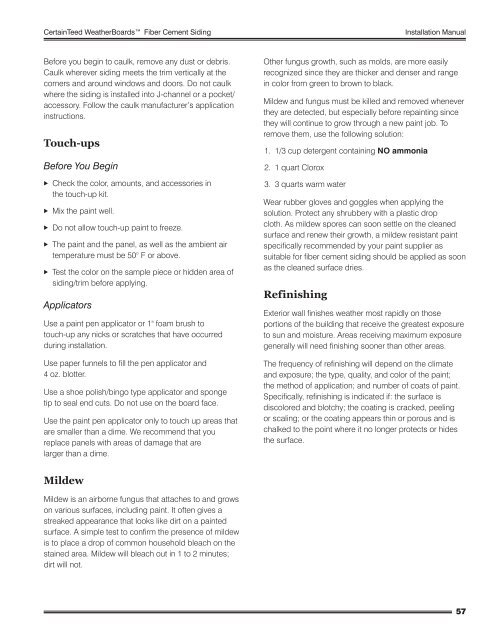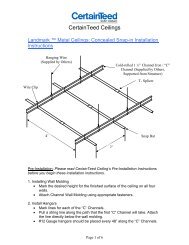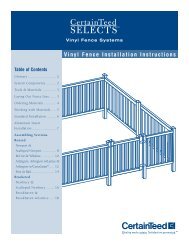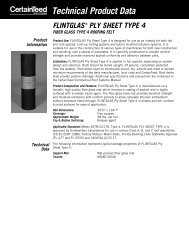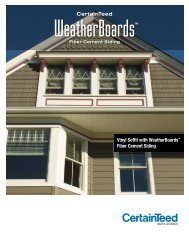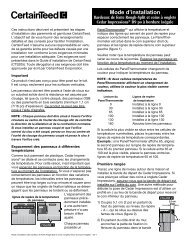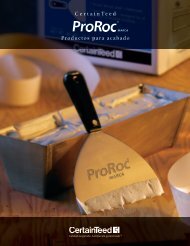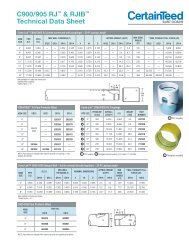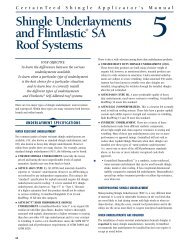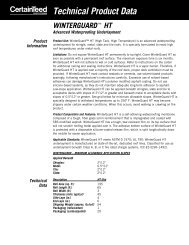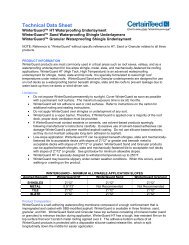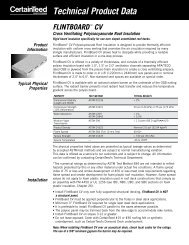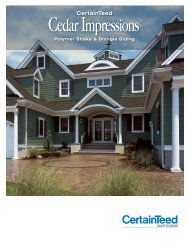Installation Manual - CertainTeed
Installation Manual - CertainTeed
Installation Manual - CertainTeed
Create successful ePaper yourself
Turn your PDF publications into a flip-book with our unique Google optimized e-Paper software.
<strong>CertainTeed</strong> WeatherBoards Fiber Cement Siding <strong>Installation</strong> <strong>Manual</strong><br />
Before you begin to caulk, remove any dust or debris.<br />
Caulk wherever siding meets the trim vertically at the<br />
corners and around windows and doors. Do not caulk<br />
where the siding is installed into J-channel or a pocket/<br />
accessory. Follow the caulk manufacturer’s application<br />
instructions.<br />
Touch-ups<br />
Before You Begin<br />
XXCheck the color, amounts, and accessories in<br />
the touch-up kit.<br />
XXMix the paint well.<br />
XXDo not allow touch-up paint to freeze.<br />
XXThe paint and the panel, as well as the ambient air<br />
temperature must be 50° F or above.<br />
XXTest the color on the sample piece or hidden area of<br />
siding/trim before applying.<br />
Applicators<br />
Use a paint pen applicator or 1" foam brush to<br />
touch-up any nicks or scratches that have occurred<br />
during installation.<br />
Use paper funnels to fill the pen applicator and<br />
4 oz. blotter.<br />
Use a shoe polish/bingo type applicator and sponge<br />
tip to seal end cuts. Do not use on the board face.<br />
Use the paint pen applicator only to touch up areas that<br />
are smaller than a dime. We recommend that you<br />
replace panels with areas of damage that are<br />
larger than a dime.<br />
Mildew<br />
Mildew is an airborne fungus that attaches to and grows<br />
on various surfaces, including paint. It often gives a<br />
streaked appearance that looks like dirt on a painted<br />
surface. A simple test to confirm the presence of mildew<br />
is to place a drop of common household bleach on the<br />
stained area. Mildew will bleach out in 1 to 2 minutes;<br />
dirt will not.<br />
Other fungus growth, such as molds, are more easily<br />
recognized since they are thicker and denser and range<br />
in color from green to brown to black.<br />
Mildew and fungus must be killed and removed whenever<br />
they are detected, but especially before repainting since<br />
they will continue to grow through a new paint job. To<br />
remove them, use the following solution:<br />
1. 1/3 cup detergent containing NO ammonia<br />
2. 1 quart Clorox<br />
3. 3 quarts warm water<br />
Wear rubber gloves and goggles when applying the<br />
solution. Protect any shrubbery with a plastic drop<br />
cloth. As mildew spores can soon settle on the cleaned<br />
surface and renew their growth, a mildew resistant paint<br />
specifically recommended by your paint supplier as<br />
suitable for fiber cement siding should be applied as soon<br />
as the cleaned surface dries.<br />
Refinishing<br />
Exterior wall finishes weather most rapidly on those<br />
portions of the building that receive the greatest exposure<br />
to sun and moisture. Areas receiving maximum exposure<br />
generally will need finishing sooner than other areas.<br />
The frequency of refinishing will depend on the climate<br />
and exposure; the type, quality, and color of the paint;<br />
the method of application; and number of coats of paint.<br />
Specifically, refinishing is indicated if: the surface is<br />
discolored and blotchy; the coating is cracked, peeling<br />
or scaling; or the coating appears thin or porous and is<br />
chalked to the point where it no longer protects or hides<br />
the surface.<br />
57


